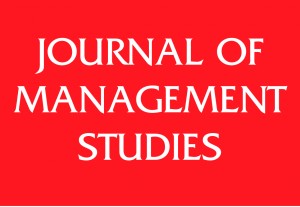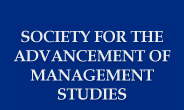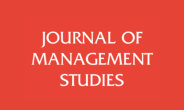
Call for Papers for a Special Issue
Heuristics and Biases of Top Managers
Submission Deadline: 29 February 2020
Guest Editors:
Barbara Burkhard, University of St Gallen, Switzerland
Nicolai Foss, Bocconi University, Italy
Dietmar Grichnik, University of St Gallen, Switzerland
Gerard P. Hodgkinson, University of Manchester, UK
Yi Tang, Hong Kong Baptist University &
University of Hong Kong, Hong Kong (after June 2019)
Marc van Essen, University of South Carolina, USA
JMS Editor:
Riikka Sarala, University of North Carolina – Greensboro, USA
BACKGROUND
While integrating psychology insights into management research has a long history, it has gained momentum over the past decade (Hambrick & Crossland, 2018; Powell, Lovallo, & Fox, 2011). Scholars increasingly examine behavioral foundations of macro-management research, using cognitive, motivational and social psychology perspectives (Foss & Weber, 2016; Hodgkinson & Healey, 2011). A central impetus has been to understand top managers’ behavior to better explain why organizations act and perform in a certain way. In particular, scholars have identified heuristics (i.e., cognitive shortcuts) and consequent cognitive biases (i.e., systematic deviation from rational norms that may arise from cognitive shortcuts) as one of the most important psychological phenomena that influence management and organizations (Powell et al., 2011; Zhang & Cueto, 2017).
Because top managers play a pivotal role in shaping major organizational outcomes (Hambrick, 2007; Hambrick & Mason, 1984), it is highly relevant to understand how top managers’ heuristics and the potential consequent biases influence decisions and outcomes in organizations. Although the influence of heuristics and biases for management and organizations has been of particular interest within the strategy domain, recent research has shown that heuristics and biases are of major importance for decision making in entrepreneurship (Shepherd, Williams & Patzelt, 2015), innovation (Galasso & Simcoe, 2011), international business (Aharoni, Tihanyi & Connelly, 2011), family firms (Fang, Siau, Memili & Dou, 2018), corporate governance (Van Ees, Gabrielsson & Huse, 2009), and leadership (Haynes, Hitt & Campbell, 2015).
Traditionally, behavioral decision theory has dominated much of the heuristics and biases literature (Slovic, Fischhoff & Lichtenstein, 1977) emphasizing that heuristics and any attendant biases can lead to second-best and error-prone decisions (Tversky & Kahneman, 1974). However, more recent developments in behavioral decision theory question the adequacy of this approach. For example, Gigerenzer and colleagues (1999) identified a new class of “fast and frugal” heuristics, which can enable rather than limit decision making. Similarly, at the organizational level, Bingham and Eisenhardt (2011) show how firms can apply heuristics to facilitate their strategy making in uncertain environments. In addition, other theoretical approaches, such as dual-process theories (Evans, 2008) and naturalistic decision making (Klein, 2008), have evolved in parallel with behavioral decision theory. Although the existing literature provides a basis for understanding the effects of top managers’ heuristics and biases, to further develop this important research stream, novel approaches and studies on this topic are needed.
AIMS AND SCOPE
In this Special Issue (SI), we call for conceptual and empirical papers that advance research in management studies by examining how, when, and under which conditions top managers’ heuristics and their consequent cognitive biases affect decisions and subsequent organizational outcomes. The focus of this SI is on top managers’ heuristics and cognitive biases while embedding them in broader conversations related to management and organizations.
Examples of potential methods to address top managers’ heuristics and biases include literature reviews (Crossan & Apaydin, 2010), meta-analyses (Sleesman, Conlon, McNamara & Miles, 2012), conceptual models (Haynes et al., 2015), grounded theory (Huang, 2018), qualitative case studies (Tyler & Gnyawali, 2009), ethnography (Liu & Maitlis, 2012), protocol analysis (Hodgkinson & Sadler-Smith, 2018), survey research (Li & Tang, 2010), archival sources (Graffin, Boivie & Carpenter, 2013), experience sampling (Aguinis & Edwards, 2014), and mixed-method designs (Huang & Pearce, 2015). Submissions that include multi-method and multi-level designs are strongly encouraged. However, please note that, in line with the journal’s emphasis on relevance to management practice, empirical investigations based on student samples or research that solely relies on models that simulate behavior within and/or between organizations will not be published in the Special Issue.
With this SI we aim to accomplish the following four aspects. First, this SI seeks to reconcile different streams of research related to negative and positive consequences of heuristics and consequent biases through more nuanced understanding of how, when and under which conditions they effect management and organizations. Second, prior research has tended to converge towards a few dominant heuristics and biases. This SI seeks to motivate researchers to explore less studied, yet relevant, heuristics and biases in order to provide a richer understanding of these concepts and the related processes. Third, this SI strives to explore the interplay of heuristics and biases with other cognitive, psychological, or social processes that influence management and organizational outcomes. Heuristics and their consequent biases do not operate in isolation, but other psychological or social processes may occur simultaneously reflecting the embeddedness of these processes within organizations. Finally, managers lead many different types of firms, such as state vs. private-owned firms, small and medium-sized enterprises, multinational enterprises, family firms, startups, and high-growth ventures. Accordingly, managers are confronted with many different types of decisions, levels of discretion, and groups of stakeholders that may influence the dynamics around heuristics and the consequent biases. In this SI, we seek to explore the consequences of heuristics and biases in different types of firms.
Contributions may address, but are not limited to, the following topics:
- Boundary conditions of heuristics and the consequent biases:
- Are top manager’s heuristics and the consequent biases always irrational? Can heuristics and biases be interpreted as rational for firm strategy and outcomes?
- How does the context (task, cultural, and social) and individual-level characteristics influence heuristics and any attendant biases of top managers? Do heuristics and their accompanying biases have in some context a functional role while dysfunctional in others?
- What is the role of temporality (time) in top managers’ heuristics, any attendant biases, and organizational outcomes?
- Different types of heuristics and their consequent biases:
- To what extent do entrepreneurs rely on intuition? How does entrepreneurial experience influence intuitive decisions? Are intuitively evaluated business opportunities as good as more conscious and analytical evaluated opportunities?
- What is the influence of status quo bias in succession planning in family firms?
- To what extend does the reliance on established rules in board decision making lead to a myopia bias?
- Interplay of heuristics and the resulting biases with other cognitive, psychological or social processes:
- What is the role of emotion in top managers’ biases? How do emotions influence biases and how do biases influence emotions? How do the interactions between biases and emotions influence managerial actions and organizational outcomes?
- How are heuristics and their accompanying biases socially constructed in a top management team? Can they be sources of conflict within the team?
- How do heuristics in organizations interact with other cognitive constructs? Do they co-evolve? Which cognitive constructs hinder or foster the emergence of heuristics?
- Heuristics and consequent biases that are related to specific types of firms/decisions:
- How do heuristics and the consequent biases influence entry mode choices? How do they change during different phases of investment decision processes?
- How can heuristics and the consequent biases explain strategic decisions at different levels within multinational enterprises?
- What types of heuristics and consequent biases influence socio-emotional wealth decisions? Are family owner top managers more prone to biases than external top managers?
SUBMISSION PROCESS AND DEADLINES
- The deadline for submissions is 29 February 2020
- Submissions should be prepared using the JMS Manuscript Preparation Guidelines (http://www.socadms.org.uk/wp-content/uploads/JMS-Manuscript-Preparation-Guidelines.pdf)
- Manuscripts should be submitted by e-mail to Gemma Parkinson at business.jms@durham.ac.uk
- Papers will be reviewed according to the JMS double-blind review process.
- We welcome informal enquiries relating to the Special Issue, proposed topics and potential fit with the Special Issue objectives. Please direct any questions on the Special Issue to the Guest Editors:
- Barbara Burkhard: burkhard@unisg.ch
- Nicolai Foss: foss@unibocconi.it
- Dietmar Grichnik: grichnik@unisg.ch
- Gerard P. Hodgkinson: hodgkinson@manchester.ac.uk
- Yi Tang: msytang@hkbu.edu.hk or bomatang@gmail.com
- Marc van Essen: vanessen@moore.sc.edu
Special Issue Workshop
To help authors advance their manuscripts, the guest editors of the Special Issue will organize a paper development workshop at University of St. Gallen (Switzerland) in June or July 2020. Authors of R&R manuscripts will be invited to attend this workshop. Please note that participation at the workshop will not guarantee acceptance of the paper for publication in JMS. Attending the workshop will not be a precondition for acceptance into the Special Issue.
REFERENCES
Aguinis, H. and Edwards, J. R. (2014). ‘Methodological wishes for the next decade and how to make wishes come true’. Journal of Management Studies, 51, 143-74.
Aharoni, Y., Tihanyi, L. and Connelly, B. L. (2011). ‘Managerial decision-making in international business: A forty-five-year retrospective’. Journal of World Business, 46, 135-42.
Bingham, C. B. and Eisenhardt, K. M. (2011). ‘Rational heuristics: the ‘simple rules’ that strategists learn from process experience’. Strategic Management Journal, 32, 1437-64.
Chen, G., Crossland, C. and Luo, S. (2015). ‘Making the same mistake all over again: CEO overconfidence and corporate resistance to corrective feedback’. Strategic Management Journal, 36, 1513-35.
Crossan, M. M. and Apaydin, M. (2010). ‘A multi‐dimensional framework of organizational innovation: A systematic review of the literature’. Journal of Management Studies, 47, 1154-91.
Evans, J. S. B. (2008). ‘Dual-processing accounts of reasoning, judgment, and social cognition’. Annual Review of Psychology, 59, 255-78.
Fang, H. C., Siau, K. L., Memili, E. and Dou, J. (2018). ‘Cognitive antecedents of family business bias in investment decisions: A commentary on ‘risky decisions and the family firm bias: An experimental study based on prospect theory’’. Entrepreneurship Theory and Practice, DOI: 1042258718796073.
Foss, N. J. and Weber, L. (2016). ‘Moving opportunism to the back seat: Bounded rationality, costly conflict, and hierarchical forms’. Academy of Management Review, 41, 61-79.
Galasso, A. and Simcoe, T. S. (2011). ‘CEO overconfidence and innovation’. Management Science, 57, 1469-84.
Gigerenzer, G. and Todd, P. M. (1999). ‘Fast and frugal heuristics: The adaptive toolbox’. In Simple heuristics that make us smart. Oxford: Oxford University Press.
Graffin, S. D., Boivie, S. and Carpenter, M. A. (2013). ‘Examining CEO succession and the role of heuristics in early‐stage CEO evaluation’. Strategic Management Journal, 34, 383-403.
Hambrick, D. C. (2007). ‘Upper echelons theory: An update’. Academy of Management Review, 32, 334-43.
Hambrick D. C., and Crossland, C. (2018). ‘A Strategy for Behavioral Strategy: Appraisal of Small, Midsize, and Large Tent Conceptions of This Embryonic Community‘. In Augier, M., Fang, C. and Rindova, V. P. (Eds.), Behavioral Strategy in Perspective (Advances in Strategic Management), Bingley: Emerald Publishing Limited, 39, 23-39.
Hambrick, D. C. and Mason, P. A. (1984). ‘Upper echelons: The organization as a reflection of its top managers’. Academy of Management Review, 9, 193-206.
Haynes, K. T., Hitt, M. A. and Campbell, J. T. (2015). ‘The dark side of leadership: Towards a mid‐range theory of hubris and greed in entrepreneurial contexts’. Journal of Management Studies, 52, 479-505.
Hodgkinson, G. P. and Healey, M. P. (2011). ‘Psychological foundations of dynamic capabilities: Reflexion and reflection in strategic management’. Strategic Management Journal, 32, 1500-16.
Hodgkinson, G. P. and Sadler-Smith, E. (2018). ‘The dynamics of intuition and analysis in managerial and organizational decision making’. Academy of Management Perspectives, 32, 473-92.
Huang, L. (2018). ‘The role of investor gut feel in managing complexity and extreme risk’. Academy of Management Journal, 61, 1821-47.
Huang, L. and Pearce, J. L. (2015). ‘Managing the unknowable: The effectiveness of early-stage investor gut feel in entrepreneurial investment decisions’. Administrative Science Quarterly, 60, 634-70.
Klein, G. (2008). ‘Naturalistic decision making’. Human Factors, 50, 456-60.
Li, J. and Tang, Y. I. (2010). ‘CEO hubris and firm risk taking in China: The moderating role of managerial discretion’. Academy of Management Journal, 53, 45-68.
Liu, F. and Maitlis, S. (2014). ‘Emotional dynamics and strategizing processes: A study of strategic conversations in top team meetings’. Journal of Management Studies, 51, 202-34.
Powell, T. C., Lovallo, D. and Fox, C. R. (2011). ‘Behavioral strategy’. Strategic Management Journal, 32, 1369-86.
Shepherd, D. A., Williams, T. A. and Patzelt, H. (2015). ‘Thinking about entrepreneurial decision making: Review and research agenda’. Journal of Management, 41, 11-46.
Sleesman, D. J., Conlon, D. E., McNamara, G. and Miles, J. E. (2012). ‘Cleaning up the big muddy: A meta-analytic review of the determinants of escalation of commitment’. Academy of Management Journal, 55, 541-62.
Slovic, P., Fischhoff, B. and Lichtenstein, S. (1977). ‘Behavioral decision theory’. Annual Review of Psychology, 28, 1-39.
Tversky, A. and Kahneman, D. (1974). ‘Judgment under uncertainty: Heuristics and biases’. Science, 185, 1124-31.
Tyler, B. B. and Gnyawali, D. R. (2009). ‘Managerial collective cognitions: An examination of similarities and differences of cultural orientations’. Journal of Management Studies, 46, 93-126.
Van Ees, H., Gabrielsson, J. and Huse, M. (2009). ‘Toward a behavioral theory of boards and corporate governance’. Corporate Governance: An International Review, 17, 307-19.
Zhang, S. X. and Cueto, J. (2017). ‘The study of bias in entrepreneurship’. Entrepreneurship Theory and Practice, 41, 419-54.

